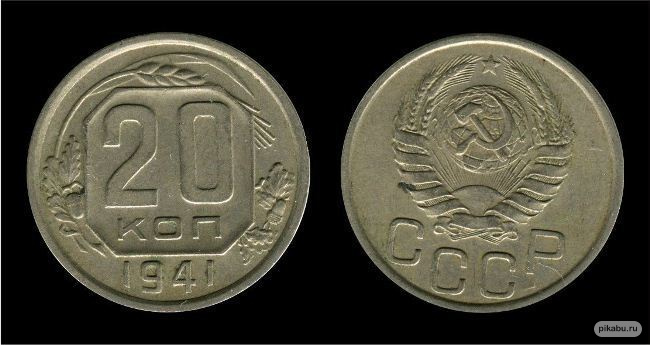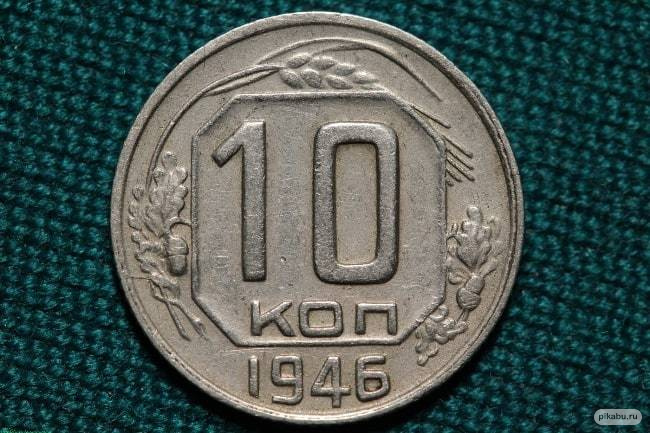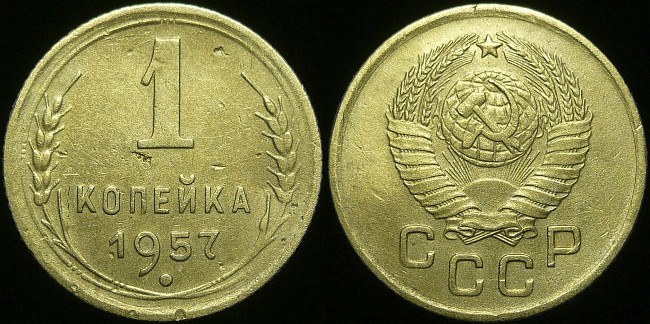10th place. 20 kopecks of the year 1941 50,000 – 100,000 rubles.

The coin of 20 kopecks denomination of the year 1941 is known for having 4 types. One of the versions was basic and unremarkable. And the other three had their own peculiarities. Now such coins can be sold for 50,000-100,000 rubles for 1 kopeck.
9th place. 10 kopecks of the year 1946 – 100,000 rubles.

In those times, 10 kopecks were minted in great numbers. There were both error and special mint-made coins – none of them were particularly valuable. But many decades later, the value has increased enormously.
8th place. 10, 15, 20 kopecks of the year 1931 – 150,000 rubles.

In 1925, they were looking for a substitution of silver for mintage. There were experiments on fractional coins with denominations of 10, 15 and 20. There were used many alloys. And only in 1930 they came to the conclusion that melchior could be used instead of silver.
Also, together with the material, they decided to change the design. The propaganda motives shown on the posters were taken as a basis. Such a design has already been on silver rubles of the year 1924 and fifty kopecks of the year 1927. The reverse was decorated with a hammerman.
Now old coins are very rare, although they were made a lot. Collectors are ready to pay 150,000 rubles for an old-pattern kopeck made of silver.
7th place. Gold chervonets from the year 1923 – 150,000 rubles.

The chervonets was minted at the Petrograd Mint from 1923 to 1924 for the foreign economy of the Soviet Union. Despite the mintage of 2,750,000 samples, the dime was not used in domestic circulation, and it has survived until our times in small quantities.
A larger number of old chervonets were melted back into gold bars and re-minted into new money with different dates set retroactively. This whole thing was done due to the fact the old royal gold inspired more confidence on the market than the new socialist gold.
Collectors are «chasing» an old-pattern gold chervonets. They are ready to pay 150,000 rubles for it.
6th place. 5 kopecks of the year 1961 – 200,000 rubles.

For the minting of 5 kopecks of the year 1961 there were used three stamps of the front side (2.1; 2.2; No. 3) and two of the reverse side (A; Б). The front side stamps differed in the number of culms between the second and third right lower coils of the tape. A stamp for 50 kopecks was also used, but such samples were very few. The difference was in the distance between the letters S and R in the abbreviation of the USSR.
The coin with a combination of 2.2–Б is considered the rarest. There are so few of them that some people are ready to buy it for 200,000 rubles.
5th place. 1 kopeck of the year 1957 – 600,000 rubles .

Kopecks were issued from 1926 until the collapse of the USSR. The small coin had a weight of one gram and was one and a half centimeters in diameter. Its thickness barely reached one millimeter.
Minting with the date of the year 1957 and a denomination of 1 kopeck began at the end of 1956. They made a one-kopeck coin until 1959 year, the mintage was more than 100 million pieces. The most desirable fractional coin made of aluminum bronze differs from others in that it has 16 coils of the tape instead of 15. Its rarity rating is «P5».
In 2010, it was put up for sale with an original price of 150,000 rubles. Many people wanted to get a valuable sample. At the end of the trade, the price of an expensive kopeck of the USSR was 600,000 rubles. The further fate of the expensive coin is unknown.
4th place. 15 kopecks of the year 1947 – 1 million rubles.

The fate of 15 kopecks of the 1947 year sample is very doleful. It was minted as a pre-release version, but it never got into circulation – the whole lot was destroyed. The reason is still unknown. How many coins were minted also remains a mystery. All that is known about the coin is its weight – 2.7 grams and diameter – 20 mm.
A small number of samples have been preserved, and they are held on demonstrative stands, so it is impossible to buy them. But there were people who could find the originals. They didn’t exactly rush to sell an exclusive, but still such a valuable thing is estimated at about 1 million rubles.
There are masters who counterfeit a coin and, passing it off as a real one, sell it at a low price.
3rd place. Special coins for vending machines of the year 1958 – 40,000-3.5 million rubles.

In 1958, it was decided to make special money for vending machines. This was done to increase the country’s budget. Due to the use of automatic machines, it was possible to remove sellers and save on wages. Coins of high denominations were issued, as the money in use was only spent on minor purchases.
They wanted to use a new material to make new big bills with the expectation that the machine would not accept old Soviet coins. But, realizing all the inconveniences of the simultaneous existence of two types of money with different rates, the Ministry of Finance of the USSR abandoned the idea of making new money.
After the reform in 1961, the old fractional coin became suitable for trade again, some of it was given to the rural banks. The money for the machines made in 1958 was sent for recycling. But despite the prohibition on their use many coins were stolen.
The money that nobody needed at that time became extremely rare. Up to 3.5 million rubles can be paid for a well-preserved sample.
2nd place. Copper chervonets of the year 1925 – 5 million rubles.

The Chervonets was issued in 1925 with the coat of arms of the USSR. The new coins were made of copper, not gold like the old ones. In other qualities the chervonets were identical.
For 2018, copper chervonets of the year 1925 is a very rare thing. They are so rare that in 2008 at auction one of the samples was sold for 5,000,000 rubles.
1st place. 50 kopecks of the year 1929 – 10 million rubles.

In 1930, new copper coins of denominations of 10, 15 and 20 kopecks began to be minted. It was decided to stop producing high-denomination variants. But after a long time, documents about the existence of equipment for the manufacture of fifty kopecks of the year 1929 were found in the archive of the Leningrad Mint . However, the records were questioned until the same coin appeared at one of the auctions.
On the front side there is a countryman driving a tractor, and on the back – one-story houses and a country road.
The fifty-kopeck piece was made of a copper-nickel alloy as a trial sample. There is no more information about the existence of such samples in the world, which makes this sample truly unique. In 2011, at the «Sign» auction, the coin was sold for 10 million rubles.
